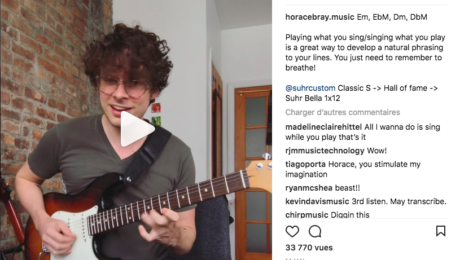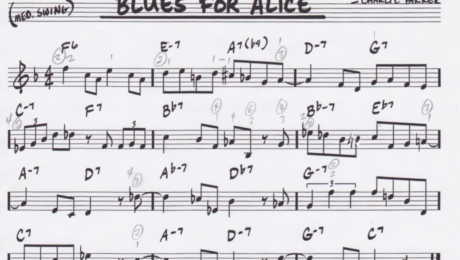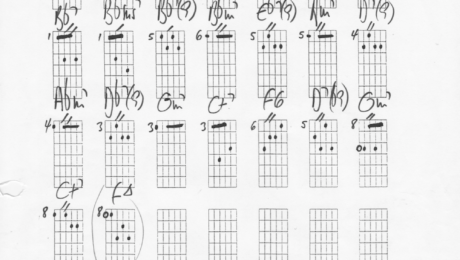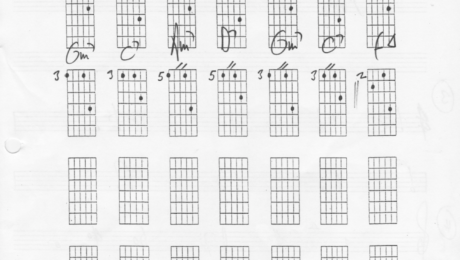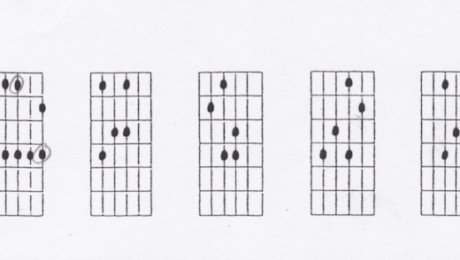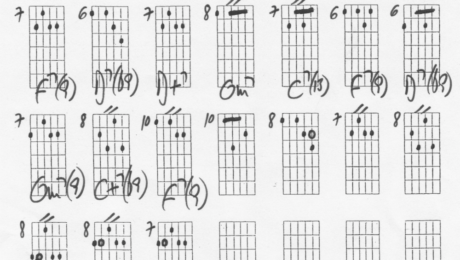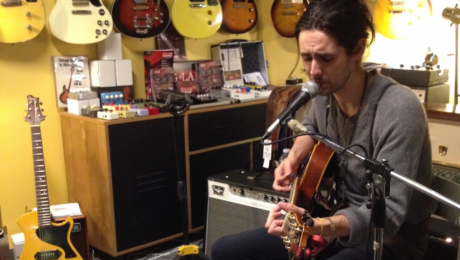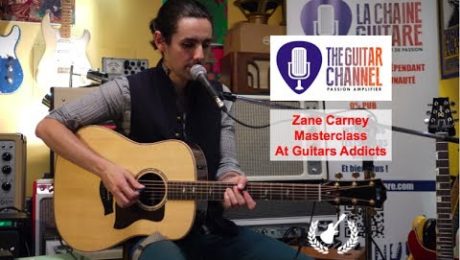Instagram gem – Horace Bray jazzy groove transcribed by Kevin Davis
Instagram is a social network full of exceptional musicians. Horace Bray (@horacebray.music) is one of those. This Instagram gem particularly attracted my ear when I watched it because Horace uses an unusual chord progression (at least for me!): Em7 / EbM7 / Dm7 / DbM7. This chromatic descent is fascinating, especially when you see what
- Published in Improve your playing
We are continuing our series on “Blues For Alice” with a little improvisation exercise. Yes, we are finally going to improvise freely! However, the one and only restriction is that we are going to use quarter notes only... The challenge is to generate a flowing, uninterrupted, sequence of quarter notes-- while still outlining the changes.
Now, before you start wondering why anyone would want to do that, let me explain that it is just an exercise.
- Published in Improve your playing
We are continuing our series on “Blues For Alice” with an arpeggio study. All of the arpeggios played here are ascending. Note that we are not playing all of the arpeggios in this particular study: since there are so many ii-Vs in sequences, I chose to only play the 3rd of most Dominant 7 chords.
Blues for Alice (Part 5/6) - An arpeggio study
I wrote some diagrams above the music notation to indicate optional fingerings for some of the lines.
This study should give you some ideas for creating your own lines while improvising.
- Published in Improve your playing
“Blues for Alice” by Bruno Pelletier-Bacquaert : 4-note groupings
We are continuing our series on “Blues For Alice” with the 4-note groupings. What we call 4-note groupings are simple patterns that are used to outline a chord progression.
- Published in All, Improve your playing
Comping means “to accompany”.
- Published in All, Improve your playing
We are continuing our study of “Blues For Alice” with 2 simple comping studies.
- Published in Improve your playing
“Blues For Alice” is a great Charlie Parker tune. It is a 12-bar Blues, but it moves through a lot of ii-V sequences. That modified version of the Blues is usually referred to as “Bird Blues” changes.
Blues for Alice (Part 1/6)
The lead sheet shows the fingerings I use. Keep in mind that those are only suggestions.
- Published in All, Improve your playing
All 7 Diatonic Arpeggios in Major Key by Bruno Pelletier-Bacquaert
This exercise will have us play through all of the arpeggios of a same tonality.
- Published in All, Improve your playing
Playing in and out of position (part 2/2) by Bruno Pelletier-Bacquaert
Here's the second part on the Playing In and Out of Position theme (part 1 is here).
- Published in Improve your playing
Playing in and out of position (part 1/2) by Bruno Pelletier-Bacquaert
Here's the first video of a two part series on the Playing In and Out of Position theme. When we first learn our Major scales, we are generally told to practice them in position. We visualize certain shapes all over the fingerboard and that helps us play more efficiently, more smoothly.
- Published in Improve your playing
Comping Study for Jazz Blues in F by Bruno Pelletier-Bacquaert
Comping means “to accompany”. In our case, it implies that those chords can be used when accompanying a soloist who is improvising over a Jazz Blues chord progression.
Comping Study for Jazz Blues in F
Each diagram represents a full measure, except when slashes are written above the chord—in which case those slashes represent the number of beats for that particular chord. The circled dots are optional replacement bass notes.
All of the chords have the root in the bass, except for the diminished 7th chord used as a substitution for the D7 chord.
- Published in All, Improve your playing
How can we make our playing more colorful, more jazz-sounding? Let’s use some guitar Chromaticism!
Using Chromaticisms simply means adding extra notes to our melodies, our arpeggios, or our scales.
- Published in Improve your playing
Here's part 2 of the Zane Carney masterclass given in Paris on May 25th 2015.
What to expect in the masterclass
In-depth talk about music theory
What to play on the V chord
Several full pieces of music played
His approach to composition
How he practice with and without the guitar
His theory about relative pitch
The story about his upcoming Jazzica signature model with Hofner
A full demo of his travel pedal board
Until the next interview, keep on playing the guitar!
Pierre.
You enjoyed this extract?
Get the Backstage Pass to watch the full video and
- Published in All, Improve your playing
Here's part 1 of the Zane Carney masterclass given in Paris on May 25th 2015.
What to expect in the full 2.5 hour masterclass
In-depth talk about music theory
What to play on the V chord
Several full pieces of music played
His approach to composition
How he practice with and without the guitar
His theory about relative pitch
The story about his upcoming Jazzica signature model with Hofner
A full demo of his travel pedal board
Until the next interview, keep on playing the guitar!
Pierre.
You enjoyed this extract?
Get the Backstage Pass to watch the full
- Published in All, Improve your playing
Here’s the fourth part out of four of the 2 plus hour masterclass Zane Carney gave in Paris at Guitars Addicts on June 25th, 2014.
The first part is here, the second here and the third here.
Enjoy,
Pierre.
- Published in Improve your playing
Here’s the third part out of four of the 2 plus hour masterclass Zane Carney gave in Paris at Guitars Addicts on June 25th, 2014.
The first part is here, the second here and the fourth here.
Enjoy,
Pierre.
- Published in Improve your playing
Here's the first part out of four of the 2 plus hour masterclass Zane Carney gave in Paris at Guitars Addicts on June 25th, 2014.
The second part is here, the third here and the fourth here.
Enjoy,
Pierre.
- Published in All, Improve your playing

